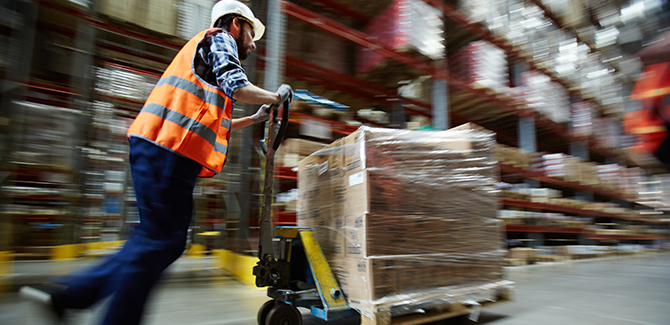
Humans Beware: Robots as Slave Drivers
Maybe it’s better if humans and robots never work side by side; or worse, if humans have a robot boss. Work could get nasty in a hurry.
“Work has always meant giving up some degree of freedom. …Workers also grant their employers wide latitude
to surveil them, and that’s also seen as basically fine, eliciting concern mostly in cases
where employers reach into workers’ private lives.
“Automated management promises to change that calculus.” —The Verge

Changing the calculus
In a work world of robots and humans, will humans always be the bottleneck to maximum productivity and efficiency…and profit? Are the differences between human and machine too great to bridge? If so, is human collaboration with a robot a fanciful dream? Is it best if humans and robots never share the same job or even the same work space?
Early returns are showing automation to be no friend of co-workers, especially if you work in a warehouse.
A fascinatingly scary look at automation that’s already here with us is presented by Josh Dzieza in The Verge. “How Hard Will the Robots Make Us Work?” is well worth a read and some reflection.
In warehouses, call centers, and other sectors, intelligent machines are managing humans, and they’re making work more stressful, grueling, and dangerous.
See related: Curse of the Digital Workplace: RoboBully
Study Finds Robots Easily Bully Office Workers
When workers chant: “We are not robots”
On conference stages and at campaign rallies, tech executives and politicians warn of a looming automation crisis — one where workers are gradually, then all at once, replaced by intelligent machines. But their warnings mask the fact that an automation crisis has already arrived. The robots are here, they’re working in management, and they’re grinding workers into the ground.
The robots are watching over hotel housekeepers, telling them which room to clean and tracking how quickly they do it. They’re managing software developers, monitoring their clicks and scrolls and docking their pay if they work too slowly. They’re listening to call center workers, telling them what to say, how to say it, and keeping them constantly, maximally busy. While we’ve been watching the horizon for the self-driving trucks, perpetually five years away, the robots arrived in the form of the supervisor, the foreman, the middle manager.
These automated systems can detect inefficiencies that a human manager never would — a moment’s downtime between calls, a habit of lingering at the coffee machine after finishing a task, a new route that, if all goes perfectly, could get a few more packages delivered in a day. But for workers, what look like inefficiencies to an algorithm were their last reserves of respite and autonomy, and as these little breaks and minor freedoms get optimized out, their jobs are becoming more intense, stressful, and dangerous. Over the last several months, I’ve spoken with more than 20 workers in six countries. For many of them, their greatest fear isn’t that robots might come for their jobs: it’s that robots have already become their boss.
In few sectors are the perils of automated management more apparent than at Amazon. Almost every aspect of management at the company’s warehouses is directed by software, from when people work to how fast they work to when they get fired for falling behind. Every worker has a “rate,” a certain number of items they have to process per hour, and if they fail to meet it, they can be automatically fired.
When Jake* started working at a Florida warehouse, he was surprised by how few supervisors there were: just two or three managing a workforce of more than 300. “Management was completely automated,” he said. One supervisor would walk the floor, laptop in hand, telling workers to speed up when their rate dropped. (Amazon said its system notifies managers to talk to workers about their performance, and that all final decisions on personnel matters, including terminations, are made by supervisors.)
Jake, who asked to use a pseudonym out of fear of retribution, was a “rebinner.” His job was to take an item off a conveyor belt, press a button, place the item in whatever cubby a monitor told him to, press another button, and repeat. He likened it to doing a twisting lunge every 10 seconds, nonstop, though he was encouraged to move even faster by a giant leaderboard, featuring a cartoon sprinting man, that showed the rates of the 10 fastest workers in real time. A manager would sometimes keep up a sports announcer patter over the intercom — “In third place for the first half, we have Bob at 697 units per hour,” Jake recalled. Top performers got an Amazon currency they could redeem for Amazon Echos and company T-shirts. Low performers got fired.
“You’re not stopping,” Jake said. “You are literally not stopping. It’s like leaving your house and just running and not stopping for anything for 10 straight hours, just running.”
See related: E-Commerce at Work: Just a Matter of Time
The churn in e-commerce warehouses is challenging humans to keep pace. Can they for very long?
Algorithmically intensified
After several months, he felt a burning in his back. A supervisor sometimes told him to bend his knees more when lifting. When Jake did this his rate dropped, and another supervisor would tell him to speed up. “You’ve got to be kidding me. Go faster?” he recalled saying. “If I go faster, I’m going to have a heart attack and fall on the floor.” Finally, his back gave out completely. He was diagnosed with two damaged discs and had to go on disability. The rate, he said, was “100 percent” responsible for his injury.
Every Amazon worker I’ve spoken to said it’s the automatically enforced pace of work, rather than the physical difficulty of the work itself, that makes the job so grueling. Any slack is perpetually being optimized out of the system, and with it any opportunity to rest or recover. A worker on the West Coast told me about a new device that shines a spotlight on the item he’s supposed to pick, allowing Amazon to further accelerate the rate and get rid of what the worker described as “micro rests” stolen in the moment it took to look for the next item on the shelf.
People can’t sustain this level of intense work without breaking down. Last year, ProPublica, BuzzFeed, and others published investigations about Amazon delivery drivers careening into vehicles and pedestrians as they attempted to complete their demanding routes, which are algorithmically generated and monitored via an app on drivers’ phones.
In November, Reveal analyzed documents from 23 Amazon warehouses and found that almost 10 percent of full-time workers sustained serious injuries in 2018, more than twice the national average for similar work. Multiple Amazon workers have told me that repetitive stress injuries are epidemic but rarely reported. (An Amazon spokesperson said the company takes worker safety seriously, has medical staff on-site, and encourages workers to report all injuries.) Backaches, knee pain, and other symptoms of constant strain are common enough for Amazon to install painkiller vending machines in its warehouses.
The unrelenting stress takes a toll of its own. Jake recalled yelling at co-workers to move faster, only to wonder what had come over him and apologize. By the end of his shift, he would be so drained that he would go straight to sleep in his car in the warehouse parking lot before making the commute home. “A lot of people did that,” he said. “They would just lay back in their car and fall asleep.” A worker in Minnesota said that the job had been algorithmically intensified to the point that it called for rethinking long-standing labor regulations.
“The concept of a 40-hour work week was you work eight hours, you sleep eight hours, and you have eight hours for whatever you want to do,” he said. “But [what] if you come home from work and you just go straight to sleep and you sleep for 16 hours, or the day after your work week, the whole day you feel hungover, you can’t focus on things, you just feel like shit, you lose time outside of work because of the aftereffects of work and the stressful, strenuous conditions?”

Workers inevitably burn out, but because each task is minutely dictated by machine, they are easily replaced. Jake estimated he was hired along with 75 people, but that he was the only one remaining when his back finally gave out, and most had been turned over twice. “You’re just a number, they can replace you with anybody off the street in two seconds,” he said. “They don’t need any skills. They don’t need anything. All they have to do is work real fast.”
There are robots of the ostensibly job-stealing variety in Amazon warehouses, but they’re not the kind that worry most workers. In 2014, Amazon started deploying shelf-carrying robots, which automated the job of walking through the warehouse to retrieve goods. The robots were so efficient that more humans were needed in other roles to keep up, Amazon built more facilities, and the company now employs almost three times the number of full-time warehouse workers it did when the robots came online.
But the robots did change the nature of the work: rather than walking around the warehouse, workers stood in cages removing items from the shelves the robots brought them. Employees say it is one of the fastest-paced and most grueling roles in the warehouse. Reveal found that injuries were more common in warehouses with the robots, which makes sense because it’s the pace that’s the problem, and the machines that most concern workers are the ones that enforce it.
Last year saw a wave of worker protests at Amazon facilities. Almost all of them were sparked by automated management leaving no space for basic human needs. In California, a worker was automatically fired after she overdrew her quota of unpaid time off by a single hour following a death in her family. (She was rehired after her co-workers submitted a petition.) In Minnesota, workers walked off the job to protest the accelerating rate, which they said was causing injuries and leaving no time for bathroom breaks or religious observance. To satisfy the machine, workers felt they were forced to become machines themselves. Their chant: “We are not robots.”
